7014ENG Case Study: Lecture Capture Upgrade Project Review
VerifiedAdded on 2022/08/28
|7
|1358
|20
Case Study
AI Summary
This case study examines a lecture capture upgrade project at an Australian University, initiated in 2017 to modernize lecture capture facilities across five campuses. The project aimed to upgrade devices in 160 classrooms within a tight timeframe, facing challenges like room access issues, lack of communication with campus security, unresponsive devices, and schedule conflicts. The study employs a descriptive research methodology, utilizing secondary data from project records and documents to analyze the project's scope, risk, and cost management. Findings reveal problems in communication, project planning, and scheduling, leading to delays and increased costs. The case study recommends improved scheduling, risk management strategies, and clear communication between project teams and university staff to ensure project success. The project's deliverables included a project charter, draft plan, scope statement, cost plan, risk management plan, and schedule plan. The analysis underscores the importance of effective project management practices to overcome challenges and achieve project objectives within budget and time constraints.
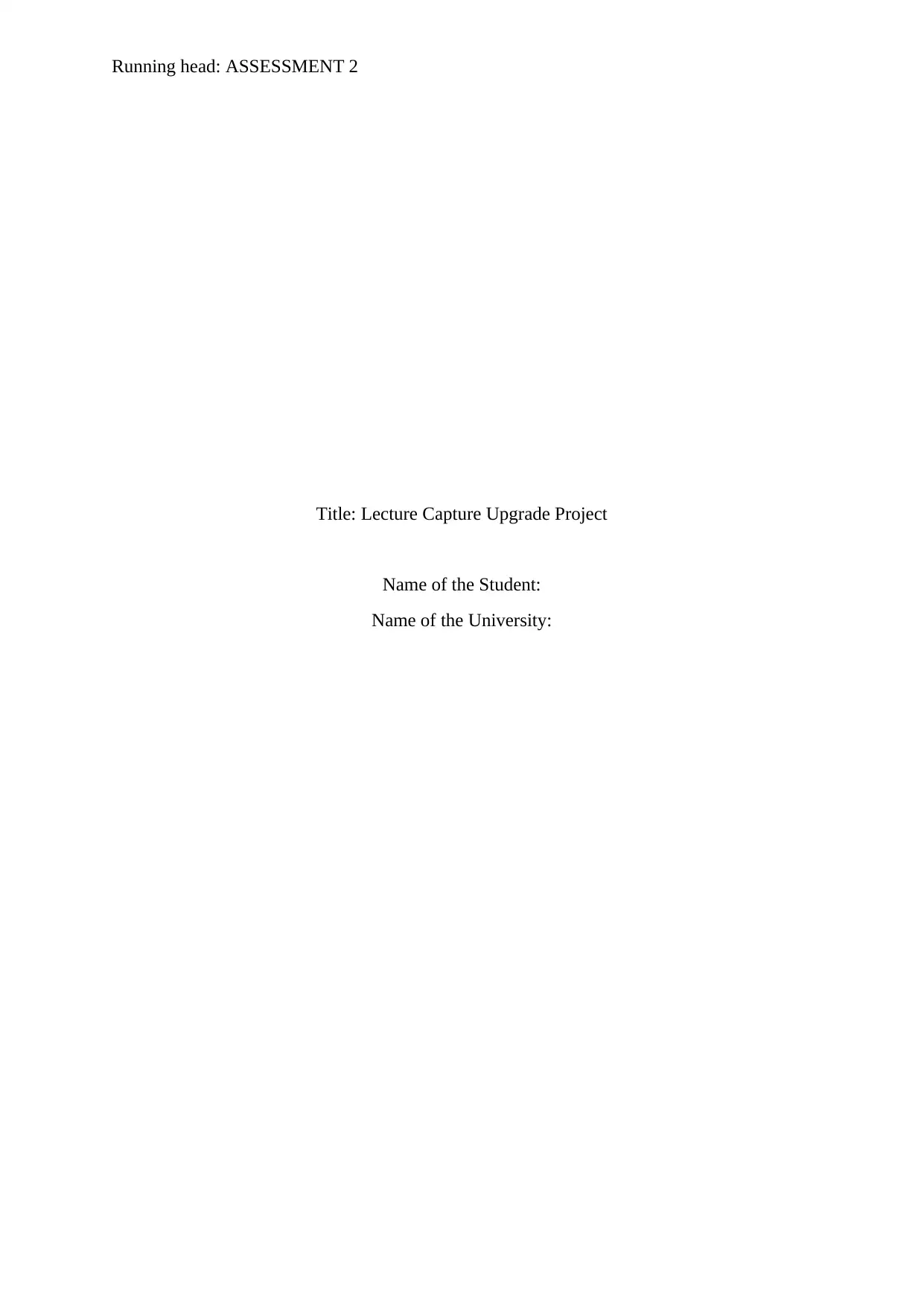
Running head: ASSESSMENT 2
Title: Lecture Capture Upgrade Project
Name of the Student:
Name of the University:
Title: Lecture Capture Upgrade Project
Name of the Student:
Name of the University:
Paraphrase This Document
Need a fresh take? Get an instant paraphrase of this document with our AI Paraphraser
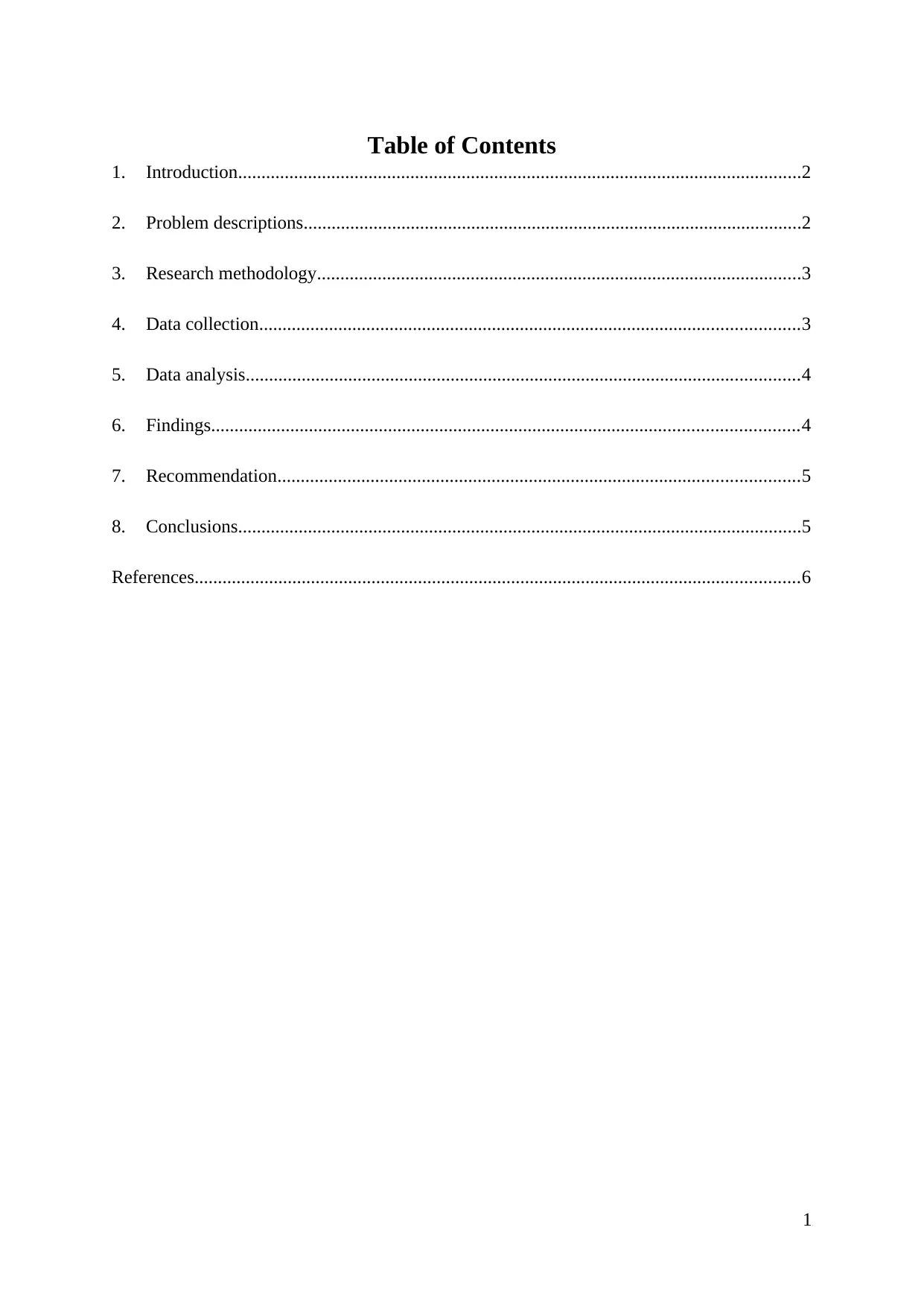
Table of Contents
1. Introduction.........................................................................................................................2
2. Problem descriptions...........................................................................................................2
3. Research methodology........................................................................................................3
4. Data collection....................................................................................................................3
5. Data analysis.......................................................................................................................4
6. Findings..............................................................................................................................4
7. Recommendation................................................................................................................5
8. Conclusions.........................................................................................................................5
References..................................................................................................................................6
1
1. Introduction.........................................................................................................................2
2. Problem descriptions...........................................................................................................2
3. Research methodology........................................................................................................3
4. Data collection....................................................................................................................3
5. Data analysis.......................................................................................................................4
6. Findings..............................................................................................................................4
7. Recommendation................................................................................................................5
8. Conclusions.........................................................................................................................5
References..................................................................................................................................6
1
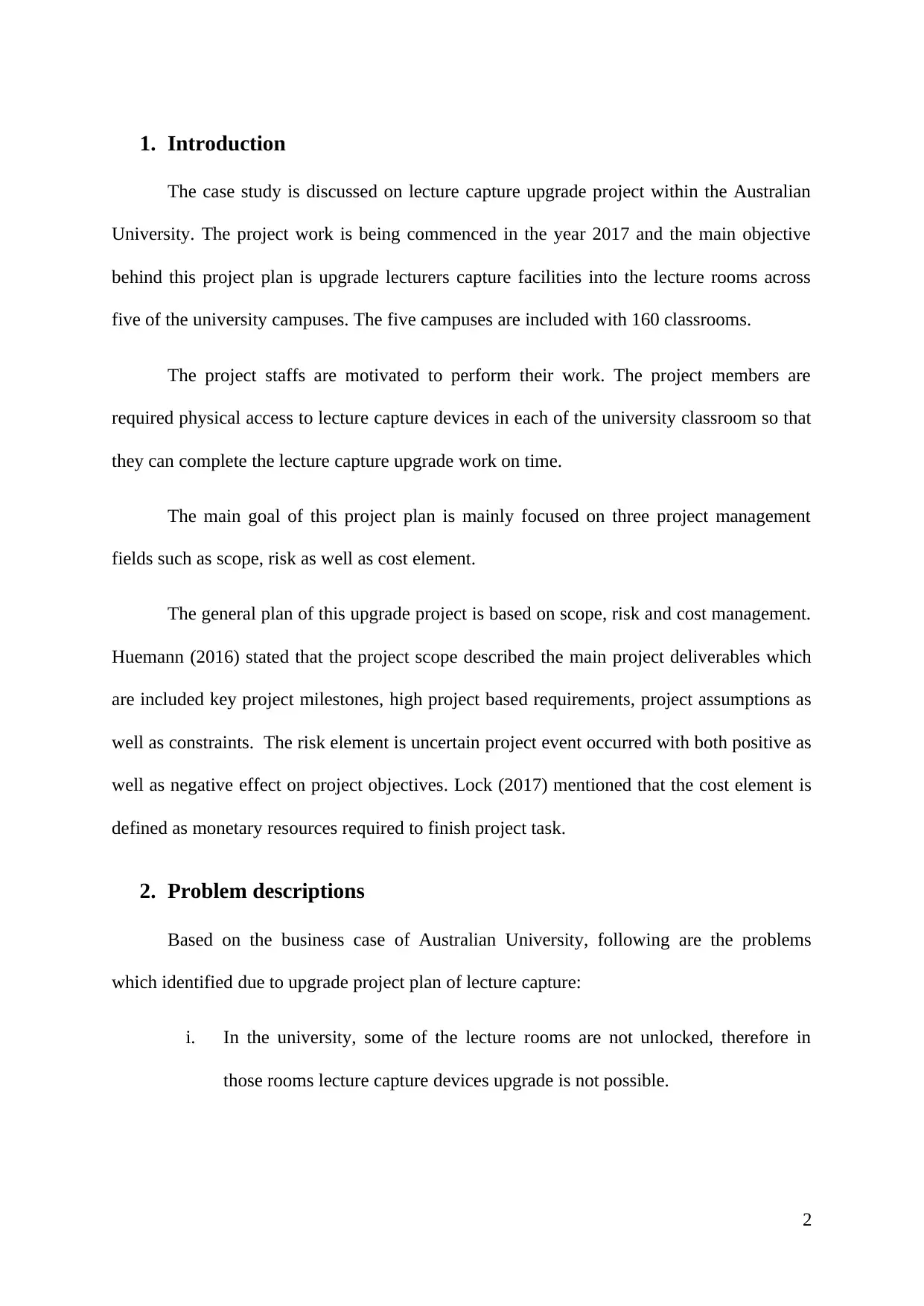
1. Introduction
The case study is discussed on lecture capture upgrade project within the Australian
University. The project work is being commenced in the year 2017 and the main objective
behind this project plan is upgrade lecturers capture facilities into the lecture rooms across
five of the university campuses. The five campuses are included with 160 classrooms.
The project staffs are motivated to perform their work. The project members are
required physical access to lecture capture devices in each of the university classroom so that
they can complete the lecture capture upgrade work on time.
The main goal of this project plan is mainly focused on three project management
fields such as scope, risk as well as cost element.
The general plan of this upgrade project is based on scope, risk and cost management.
Huemann (2016) stated that the project scope described the main project deliverables which
are included key project milestones, high project based requirements, project assumptions as
well as constraints. The risk element is uncertain project event occurred with both positive as
well as negative effect on project objectives. Lock (2017) mentioned that the cost element is
defined as monetary resources required to finish project task.
2. Problem descriptions
Based on the business case of Australian University, following are the problems
which identified due to upgrade project plan of lecture capture:
i. In the university, some of the lecture rooms are not unlocked, therefore in
those rooms lecture capture devices upgrade is not possible.
2
The case study is discussed on lecture capture upgrade project within the Australian
University. The project work is being commenced in the year 2017 and the main objective
behind this project plan is upgrade lecturers capture facilities into the lecture rooms across
five of the university campuses. The five campuses are included with 160 classrooms.
The project staffs are motivated to perform their work. The project members are
required physical access to lecture capture devices in each of the university classroom so that
they can complete the lecture capture upgrade work on time.
The main goal of this project plan is mainly focused on three project management
fields such as scope, risk as well as cost element.
The general plan of this upgrade project is based on scope, risk and cost management.
Huemann (2016) stated that the project scope described the main project deliverables which
are included key project milestones, high project based requirements, project assumptions as
well as constraints. The risk element is uncertain project event occurred with both positive as
well as negative effect on project objectives. Lock (2017) mentioned that the cost element is
defined as monetary resources required to finish project task.
2. Problem descriptions
Based on the business case of Australian University, following are the problems
which identified due to upgrade project plan of lecture capture:
i. In the university, some of the lecture rooms are not unlocked, therefore in
those rooms lecture capture devices upgrade is not possible.
2
⊘ This is a preview!⊘
Do you want full access?
Subscribe today to unlock all pages.

Trusted by 1+ million students worldwide
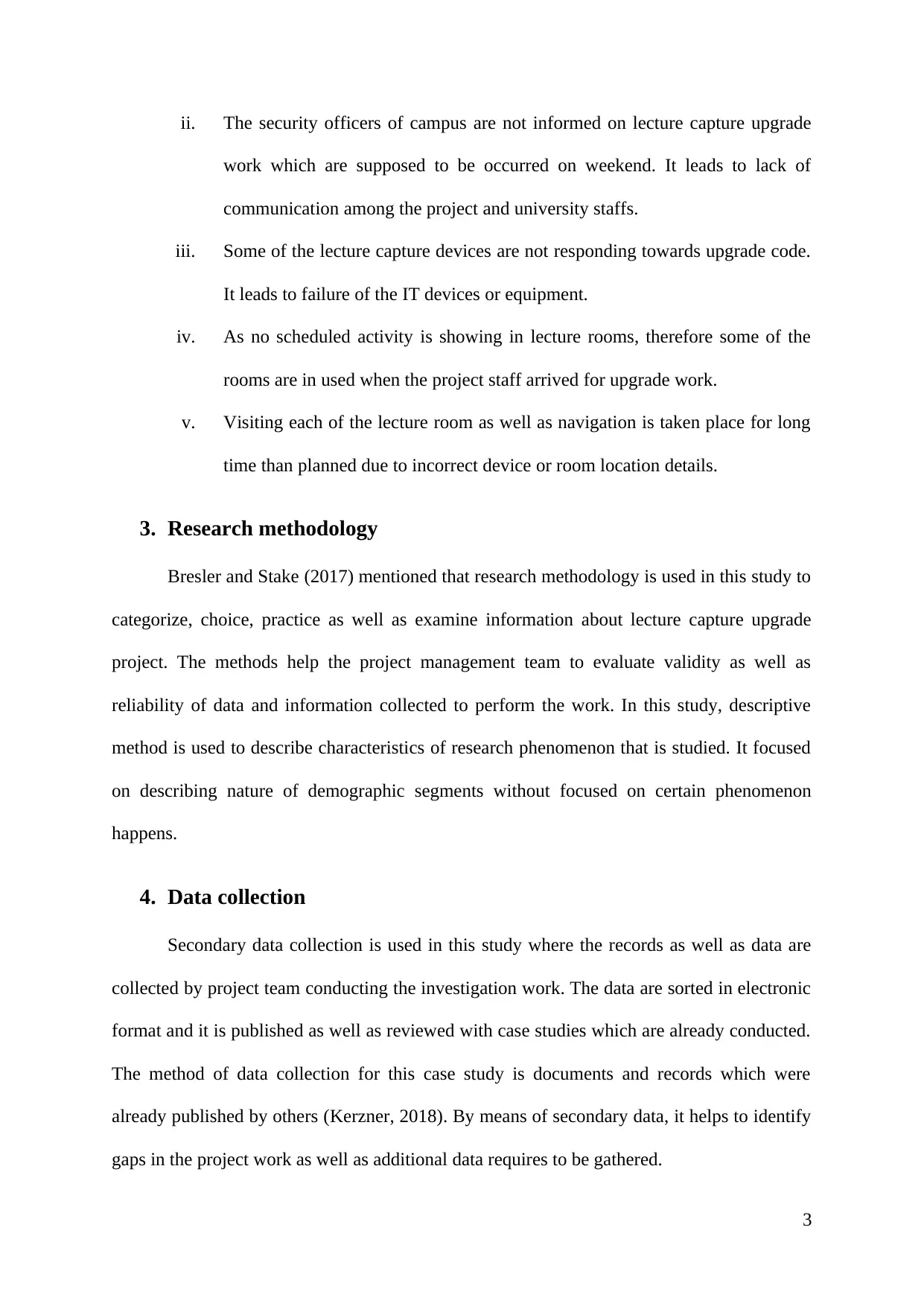
ii. The security officers of campus are not informed on lecture capture upgrade
work which are supposed to be occurred on weekend. It leads to lack of
communication among the project and university staffs.
iii. Some of the lecture capture devices are not responding towards upgrade code.
It leads to failure of the IT devices or equipment.
iv. As no scheduled activity is showing in lecture rooms, therefore some of the
rooms are in used when the project staff arrived for upgrade work.
v. Visiting each of the lecture room as well as navigation is taken place for long
time than planned due to incorrect device or room location details.
3. Research methodology
Bresler and Stake (2017) mentioned that research methodology is used in this study to
categorize, choice, practice as well as examine information about lecture capture upgrade
project. The methods help the project management team to evaluate validity as well as
reliability of data and information collected to perform the work. In this study, descriptive
method is used to describe characteristics of research phenomenon that is studied. It focused
on describing nature of demographic segments without focused on certain phenomenon
happens.
4. Data collection
Secondary data collection is used in this study where the records as well as data are
collected by project team conducting the investigation work. The data are sorted in electronic
format and it is published as well as reviewed with case studies which are already conducted.
The method of data collection for this case study is documents and records which were
already published by others (Kerzner, 2018). By means of secondary data, it helps to identify
gaps in the project work as well as additional data requires to be gathered.
3
work which are supposed to be occurred on weekend. It leads to lack of
communication among the project and university staffs.
iii. Some of the lecture capture devices are not responding towards upgrade code.
It leads to failure of the IT devices or equipment.
iv. As no scheduled activity is showing in lecture rooms, therefore some of the
rooms are in used when the project staff arrived for upgrade work.
v. Visiting each of the lecture room as well as navigation is taken place for long
time than planned due to incorrect device or room location details.
3. Research methodology
Bresler and Stake (2017) mentioned that research methodology is used in this study to
categorize, choice, practice as well as examine information about lecture capture upgrade
project. The methods help the project management team to evaluate validity as well as
reliability of data and information collected to perform the work. In this study, descriptive
method is used to describe characteristics of research phenomenon that is studied. It focused
on describing nature of demographic segments without focused on certain phenomenon
happens.
4. Data collection
Secondary data collection is used in this study where the records as well as data are
collected by project team conducting the investigation work. The data are sorted in electronic
format and it is published as well as reviewed with case studies which are already conducted.
The method of data collection for this case study is documents and records which were
already published by others (Kerzner, 2018). By means of secondary data, it helps to identify
gaps in the project work as well as additional data requires to be gathered.
3
Paraphrase This Document
Need a fresh take? Get an instant paraphrase of this document with our AI Paraphraser

5. Data analysis
Qualitative data analysis helps in developing concepts related to project topic for
better understanding the phenomenon in natural. The project manager operated the work on
assumptions that empirical evidences gathered is related to theoretical ideas based on three
project management concepts such as scope, risk and cost. Therefore, gathered or collected
data are relayed to project management concepts, values as well as behaviours of people in
social context (Humphries, 2017). The project researcher takes the project documents to give
meaning around the selected project topic.
6. Findings
After collecting data using secondary sources like documents and records based on
selected project topic, it was found that the scope of this project is upgrading the lecture
capture facilities in the lecture rooms. There is a scope to upgrade the lecture rooms across
160 classrooms of the university. After upgradation of new solution, old solution will stop
working. Upgrade work is only possible when none of the lecture rooms were not in used
(Binder, 2016). The project deliverables are project charter, draft project plan, scope
statement, cost plan, risk management plan and project schedule plan.
The main identified risks in the project are communication problems and lack of
project planning. The campus security officers were not informed on upgrade activities on
weekend, therefore there is lack of communication between the project team as well as
university staffs. The entire project work is not planned properly lead to project delays. The
project activities are not scheduled properly due to which the upgrade work is delayed (Kliem
& Ludin, 2019). There is no scheduled activity in some of the lecture rooms, while some of
them were used at the time of arriving the project staffs causes delay in project tasks.
4
Qualitative data analysis helps in developing concepts related to project topic for
better understanding the phenomenon in natural. The project manager operated the work on
assumptions that empirical evidences gathered is related to theoretical ideas based on three
project management concepts such as scope, risk and cost. Therefore, gathered or collected
data are relayed to project management concepts, values as well as behaviours of people in
social context (Humphries, 2017). The project researcher takes the project documents to give
meaning around the selected project topic.
6. Findings
After collecting data using secondary sources like documents and records based on
selected project topic, it was found that the scope of this project is upgrading the lecture
capture facilities in the lecture rooms. There is a scope to upgrade the lecture rooms across
160 classrooms of the university. After upgradation of new solution, old solution will stop
working. Upgrade work is only possible when none of the lecture rooms were not in used
(Binder, 2016). The project deliverables are project charter, draft project plan, scope
statement, cost plan, risk management plan and project schedule plan.
The main identified risks in the project are communication problems and lack of
project planning. The campus security officers were not informed on upgrade activities on
weekend, therefore there is lack of communication between the project team as well as
university staffs. The entire project work is not planned properly lead to project delays. The
project activities are not scheduled properly due to which the upgrade work is delayed (Kliem
& Ludin, 2019). There is no scheduled activity in some of the lecture rooms, while some of
them were used at the time of arriving the project staffs causes delay in project tasks.
4
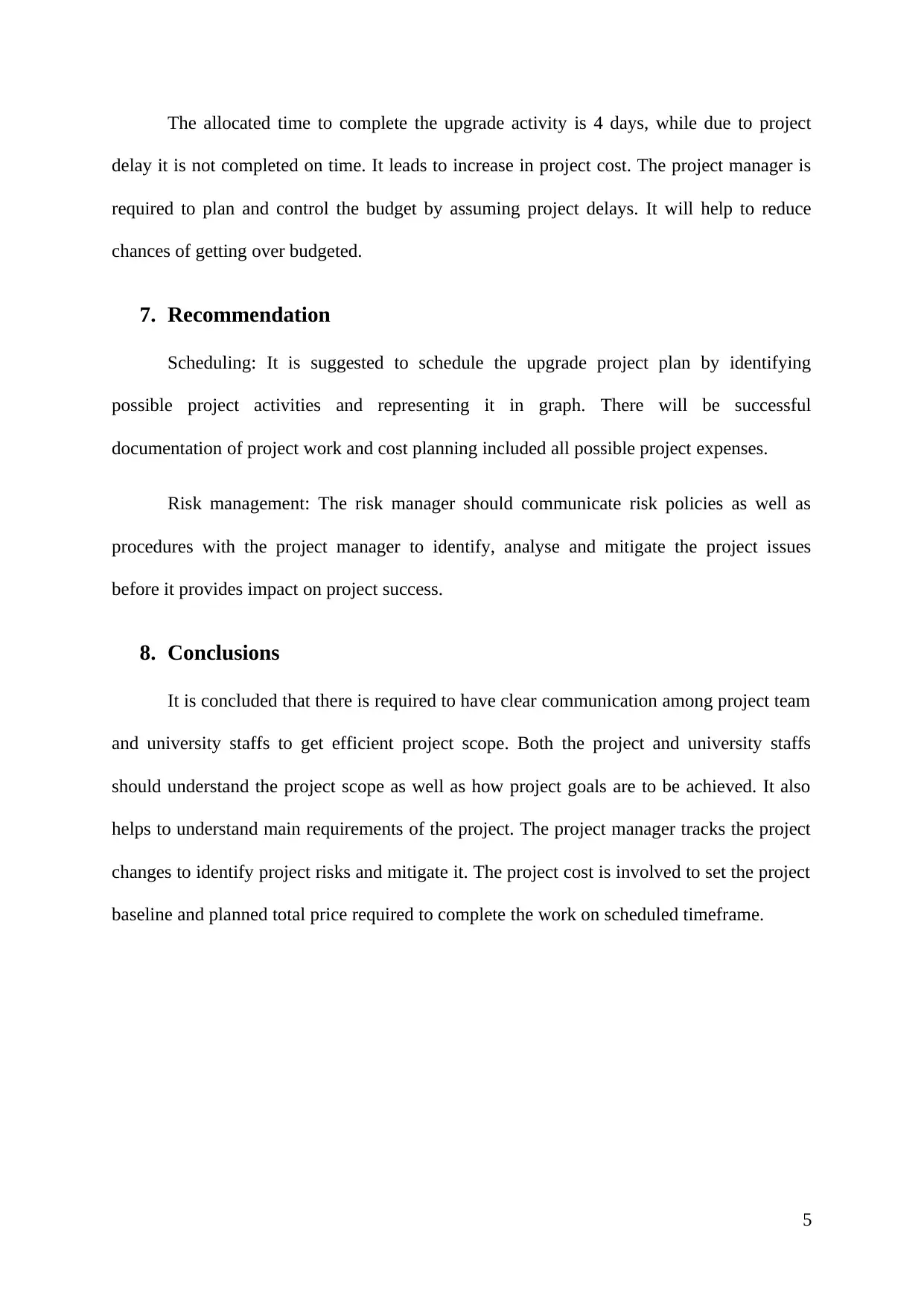
The allocated time to complete the upgrade activity is 4 days, while due to project
delay it is not completed on time. It leads to increase in project cost. The project manager is
required to plan and control the budget by assuming project delays. It will help to reduce
chances of getting over budgeted.
7. Recommendation
Scheduling: It is suggested to schedule the upgrade project plan by identifying
possible project activities and representing it in graph. There will be successful
documentation of project work and cost planning included all possible project expenses.
Risk management: The risk manager should communicate risk policies as well as
procedures with the project manager to identify, analyse and mitigate the project issues
before it provides impact on project success.
8. Conclusions
It is concluded that there is required to have clear communication among project team
and university staffs to get efficient project scope. Both the project and university staffs
should understand the project scope as well as how project goals are to be achieved. It also
helps to understand main requirements of the project. The project manager tracks the project
changes to identify project risks and mitigate it. The project cost is involved to set the project
baseline and planned total price required to complete the work on scheduled timeframe.
5
delay it is not completed on time. It leads to increase in project cost. The project manager is
required to plan and control the budget by assuming project delays. It will help to reduce
chances of getting over budgeted.
7. Recommendation
Scheduling: It is suggested to schedule the upgrade project plan by identifying
possible project activities and representing it in graph. There will be successful
documentation of project work and cost planning included all possible project expenses.
Risk management: The risk manager should communicate risk policies as well as
procedures with the project manager to identify, analyse and mitigate the project issues
before it provides impact on project success.
8. Conclusions
It is concluded that there is required to have clear communication among project team
and university staffs to get efficient project scope. Both the project and university staffs
should understand the project scope as well as how project goals are to be achieved. It also
helps to understand main requirements of the project. The project manager tracks the project
changes to identify project risks and mitigate it. The project cost is involved to set the project
baseline and planned total price required to complete the work on scheduled timeframe.
5
⊘ This is a preview!⊘
Do you want full access?
Subscribe today to unlock all pages.

Trusted by 1+ million students worldwide
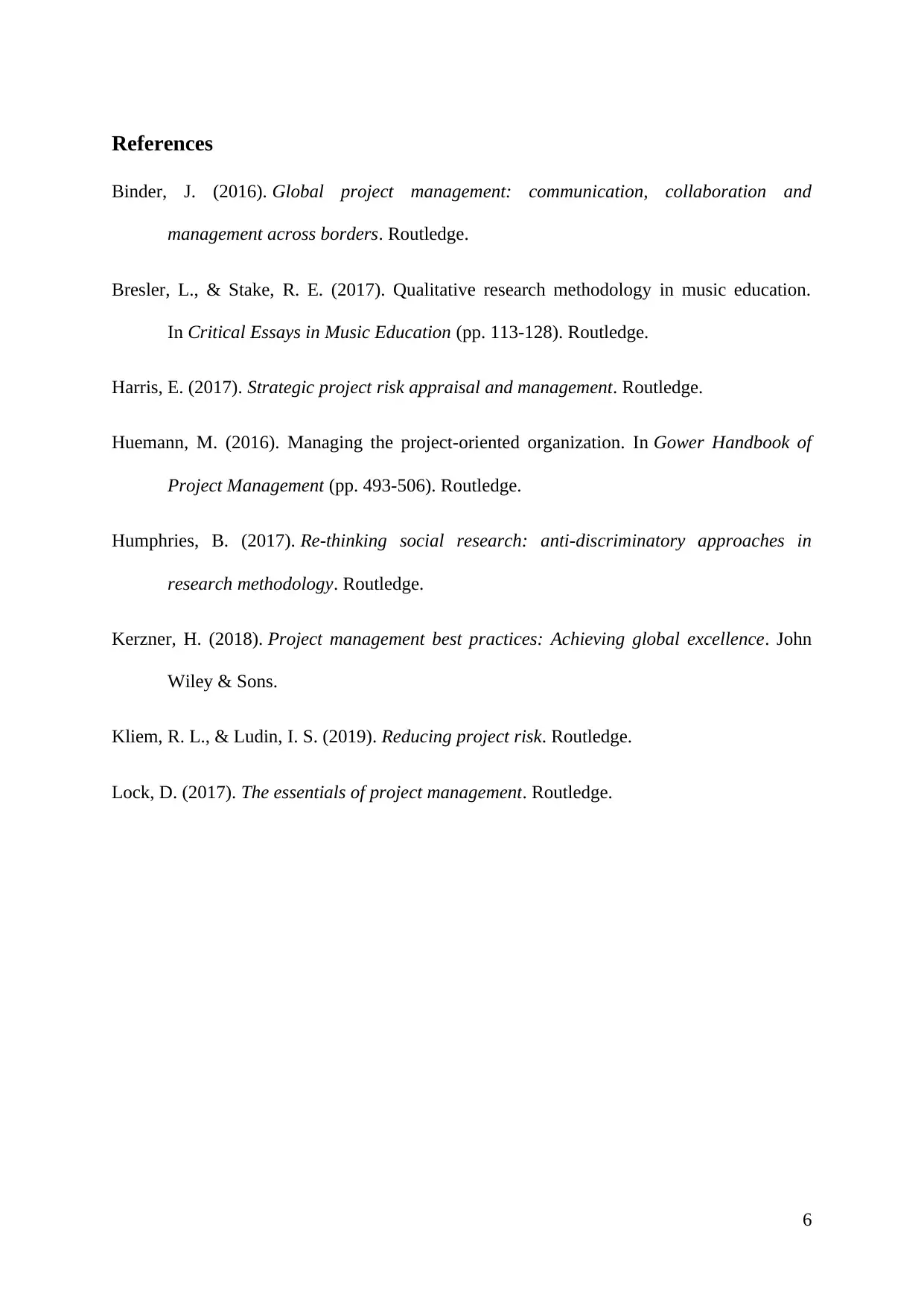
References
Binder, J. (2016). Global project management: communication, collaboration and
management across borders. Routledge.
Bresler, L., & Stake, R. E. (2017). Qualitative research methodology in music education.
In Critical Essays in Music Education (pp. 113-128). Routledge.
Harris, E. (2017). Strategic project risk appraisal and management. Routledge.
Huemann, M. (2016). Managing the project-oriented organization. In Gower Handbook of
Project Management (pp. 493-506). Routledge.
Humphries, B. (2017). Re-thinking social research: anti-discriminatory approaches in
research methodology. Routledge.
Kerzner, H. (2018). Project management best practices: Achieving global excellence. John
Wiley & Sons.
Kliem, R. L., & Ludin, I. S. (2019). Reducing project risk. Routledge.
Lock, D. (2017). The essentials of project management. Routledge.
6
Binder, J. (2016). Global project management: communication, collaboration and
management across borders. Routledge.
Bresler, L., & Stake, R. E. (2017). Qualitative research methodology in music education.
In Critical Essays in Music Education (pp. 113-128). Routledge.
Harris, E. (2017). Strategic project risk appraisal and management. Routledge.
Huemann, M. (2016). Managing the project-oriented organization. In Gower Handbook of
Project Management (pp. 493-506). Routledge.
Humphries, B. (2017). Re-thinking social research: anti-discriminatory approaches in
research methodology. Routledge.
Kerzner, H. (2018). Project management best practices: Achieving global excellence. John
Wiley & Sons.
Kliem, R. L., & Ludin, I. S. (2019). Reducing project risk. Routledge.
Lock, D. (2017). The essentials of project management. Routledge.
6
1 out of 7
Related Documents
Your All-in-One AI-Powered Toolkit for Academic Success.
+13062052269
info@desklib.com
Available 24*7 on WhatsApp / Email
![[object Object]](/_next/static/media/star-bottom.7253800d.svg)
Unlock your academic potential
Copyright © 2020–2025 A2Z Services. All Rights Reserved. Developed and managed by ZUCOL.





